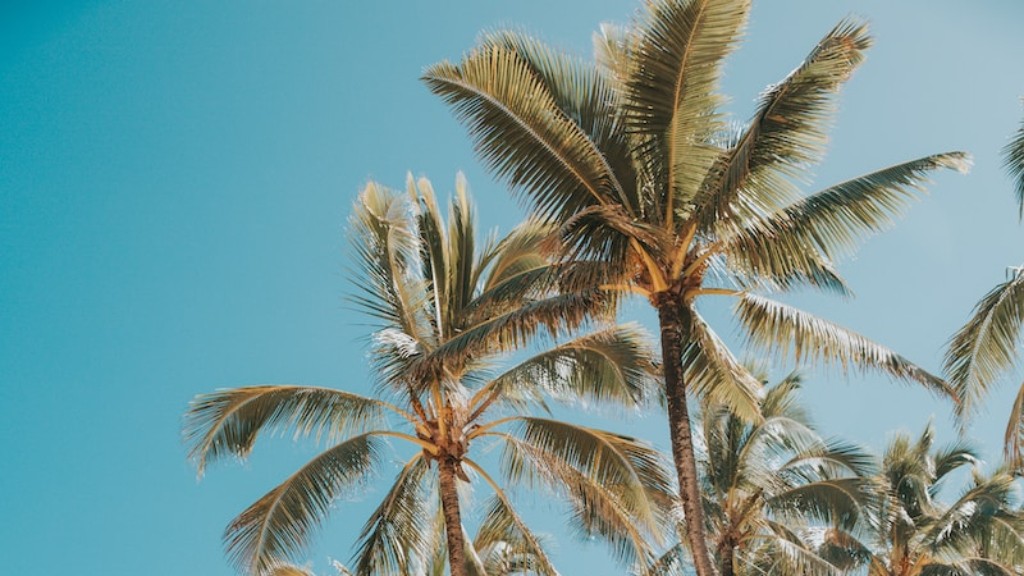Palm Trees: A Question of Toughness
For many people, palm trees are quintessential symbols of summer. But do they survive the winter season? The answer actually depends on the type of palm tree. If you purchase a palm tree that is known to be tough and hardy, it won’t require any extra protection in the winter months. It should be able to survive without a problem.
Generally speaking, mature, properly established palm trees should be sufficiently equipped to withstand winter conditions. This is especially true if the tree is planted in a sunny and sheltered spot in the garden. Even if temperatures get to freezing levels on occasion, a well-established palm tree should still have no problem making it through the winter.
In terms of additional protection, mulch may be used to give the palm tree an extra layer of insulation in case of extremely cold weather. It is important to ensure, however, that the mulch is applied when temperatures aren’t still very low, typically at the beginning of autumn.
For young or recently planted palm trees however, the situation is a bit different. It is advised to give them a bit more protection in the winter months. Usually, this means building a makeshift enclosure around the tree. This should be composed of some breathable material, such as a tarp or burlap sack loosely wrapped around the tree.
If you want to go the extra mile, some sort of heater may be employed to keep the inside of the enclosure slightly above freezing point. Just be sure that the heater is placed far away from the tree, so as to minimize the chances of burning it.
Types of Palm Trees & Winter Hardiness
Not all palm trees are the same or have the same qualities when it comes to winter hardiness. Some species actually do better in cold climates than others, able to stand up to temperatures well below zero.
The Chilean wine palm, for example, is quite hardy and can survive temperatures as low as 14 degrees Fahrenheit. The needle palm and cabbage palm can withstand even lower temperatures – 11 degrees and 5 degrees Fahrenheit, respectively.
The Chinese or Trachycarpus fortunei palm is another surprisingly tough species. It is a popular choice due to its classic beach-vacation looks, plus its cold hardiness. It is capable of withstanding temperatures down to 14 degrees, making it a lot harderier than most people expect it to be.
At the other end of the spectrum, we find tropical palm trees like the pygmy date,Areca and Christmas palm. These varieties cannot stand temperatures below 40 degrees Fahrenheit and need a more protected environment in cold weather.
What if My Palm Tree Still Doesn’t Survive?
It’s possible that despite taking the necessary measures for protection, a palm tree could still be affected by the cold weather and die. Even if the species is a cold-hardy one, it could still succumb to the harsh winter temperatures.
If this happens, good practice is to trim away any dead or damaged parts of the palm tree’s trunk, or have a specialist take a look and properly diagnose the problem.
It is also best to fertilize the tree in the spring before things start to heat up. The right fertilizer can help the tree recover, grow more quickly and prepare for the summer months ahead.
Protecting Palm Trees From Other Winter Hazards
In the winter, it isn’t only the cold temperatures that can harm a palm tree. Very strong winds, snow, ice and salt – all of which are common in winter – can also cause damage or even kill a palm tree.
This means that even if a palm tree is adequately protected from the cold, the other hazards still need to be addressed. Snow and ice should be cleared away as soon as possible, and any damage caused by the winter elements should be repaired.
Frost is another thing that can spell death for a palm tree in the winter. In some instances, a tree might freeze even in temperatures that aren’t that low. If the tree is well-protected but still suffers from frost, then a heating system of some sort should be considered to prevent freezing.
A Question of Climate Weakness
When it comes to palm trees and the winter months, it is essential to evaluate the climate around the tree. Different types of palm trees have different levels of hardiness, but the climate can still have a huge role in how the tree will fare in the winter.
If you live in an area with particularly harsh winters, then it is best to play safe and employ additional protection measures for the tree. If, on the other hand, you live in a mild climate, then the palm tree might do just fine ‘on its own’ with no extra protection.
It is also recommendable to take into account the orientation of the spot in which the tree is planted. Sunlight plays a huge role in how much warmth the tree can get and how well it survives the winter season.
Factors Influencing the Health of a Palm Tree
The first factor to consider when trying to determine the level of protection a palm tree needs in the winter is the specific species. Certain trees are inherently hardier than others, and this has to be taken into account.
The environment around the tree is also going to be significant. This includes everything from the climate and the position/orientation of the tree to any nearby trees that may affect its growth.
The condition and age of the tree is also an important aspect. A younger tree is usually in need of extra protection, thanks to its immature roots, weaker structure and lack of resistance. Older palms should usually be able to do just fine.
Finally, the way the tree has been ta ken care of and treated throughout its life is also going to influence its winter hardiness. Proper pruning and maintenance are fundamental to keeping a palm tree healthy and shielded from cold damage.
Protection & Proper Care: The Key to a Healthy Palm Tree
In order to keep palm trees safe and healthy in the winter season, it is critical to employ the right protection methods. Some species require more attention than others, and the climate around them is also a big factor.
However, the key to having a healthy palm tree all year round is still proper care and maintenance. If you take care of your tree and make sure it receives adequate food, water and sunlight, it should do just fine in the winter.
Mulching as an Additional Protection Measure
Mulching isa common practice when it comes to protecting plants and trees from the cold. By creating a protective cover of mulch around the tree, it is possible to give it an extra layer of insulation.
This practice should be done carefully and with the right materials. For palms, the ideal mulch should be composed of leaves, straw or pine straw, or even shredded fabric or burlap. This material should be spread about the circumference of the tree trunk.
Ensuring that the right materials are used is essential, as some materials contain contaminants that can damage or kill the tree. If you are not sure which mulch is suitable for your tree, consulting a specialist is always the safest option.
Risks of Over-Mulching
Though mulching can be beneficial and help protect a palm tree from the cold, there can also be risks associated with this practice. Placing too much mulch around the tree might cause the roots to rot, or lead to other issues.
When mulching, it is essential to make sure there is a three-foot space clear between the base of the tree and the mulch. This will help ensure that the tree isn’t harmed by the added protection.
Finally, as mentioned before, it is important to wait until temperatures are mild before you go ahead and start mulching. Any mulch applied when the soil is still frosty might block moisture and oxygen and suffocate the tree.
Winterizing a Palm Tree
When it comes to winterizing a palm tree and preparing it for the harsher months ahead, the process will depend on the particular species. It is advisable to research the tree before taking any steps, taking into account the location, climate and the age of the tree.
As a general rule, mature and established palms require no extra protection and won’t need to be covered or mulched. However, young or recently transplanted palms could benefit from some winterizing measures.
In such cases, the ideal protection is cover or an enclosure. This way, the tree can be shielded from the cold and any winter hazards, like winds, ice and frost.
Heaters can also be used when temperatures are especially cold and the palm tree is in need extra warmth. If so, just make sure to keep the heater away from the tree, because any contact with the trunk could cause it harm.




